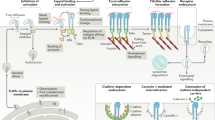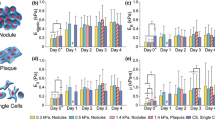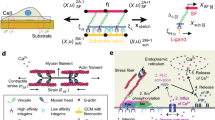Abstract
The relationship between substrate properties and cell behavior is complex, including roles for both mechanics and biochemistry. Here we investigate the role of viscous dissipation on cell adhesion behaviors, using polymer films of tunable lateral mobility. We find that fibroblasts selectively use \(\alpha _v \beta _3\) and \(\alpha _5 \beta _1\) integrin receptors to control their spreading area and polarization on low and high mobility films, respectively. In addition, the dynamics of cell spreading and polarization are well described by a semi-empirical sigmoidal relationship. Analysis of cell dynamic behavior reveals that spreading dynamics are controlled by the availability of integrins, whereas the polarization dynamics are controlled by intracellular signaling. The result that cells preferentially use specific integrin receptors in response to substrate mechanical properties has broad implications for processes in dynamic environments such as wound healing and cancer metastasis.





Similar content being viewed by others
References
Antia, M., G. Baneyx, K. E. Kubow, and V. Vogel. Fibronectin in aging extracellular matrix fibrils is progressively unfolded by cells and elicits an enhanced rigidity response. Faraday Discuss. 139:229–249; discussion 309–25, 419–20, 2008.
Bardsley, W. G., and J. D. Aplin, Kinetic analysis of cell spreading. I. Theory and modelling of curves. J. Cell Sci. 61:365–373, 1983.
Boettiger, D. Mechanical control of integrin-mediated adhesion and signaling. Curr. Opin. Cell Biol. 24:592–599, 2012.
Cao, L., M. K. Zeller, V. F. Fiore, P. Strane, H. Bermudez, and T. H. Barker, Phage-based molecular probes that discriminate force-induced structural states of fibronectin in vivo. Proc. Natl. Acad. Sci USA 109:7251–7256, 2012.
Chen, C., M. Mrksich, S. Huang, G. Whitesides, and D. Ingber, Geometric control of cell life and death. Science 276:1425–1428, 1997.
Chen, W. Y., and G. Abatangelo. Functions of hyaluronan in wound repair. Wound Repair Regen. 7:79–89, 1999.
Chen, X., Y.-D. Su, V. Ajeti, S.-J. Chen, and P. J. Campagnola, Cell adhesion on micro-structured fibronectin gradients fabricated by multiphoton excited photochemistry.Cell Mol. Bioeng. 5:307–319, 2012.
Cox, E. A., S. K. Sastry, and A. Huttenlocher, Integrin-mediated adhesion regulates cell polarity and membrane protrusion through the Rho family of GTPases. Mol. Biol. Cell 12:265–77, 2001.
Cretel, E., A. Pierres, A.-M. Benoliel, and P. Bongrand, How Cells feel their environment: a focus on early dynamic events. Cell Mol. Bioeng. 1:5–14, 2008.
Cuvelier, D., M. Théry, Y.-S. Chu, S. Dufour, J.-P. Thiéry, M. Bornens, P. Nassoy, and L. Mahadevan, The universal dynamics of cell spreading. Curr. Biol. 17:694–699, 2007.
Döbereiner, H.-G., B. Dubin-Thaler, G. Giannone, H. S. Xenias, and M. P. Sheetz, Dynamic phase transitions in cell spreading. Phys. Rev. Lett. 93:108105, 2004.
Drubin, D. G., and W. J. Nelson, Origins of cell polarity. Cell 84:335–344, 1996.
Dumbauld, D. W., H. Shin, N. D. Gallant, K. E. Michael, H. Radhakrishna, and A. J. Garcia, Contractility modulates cell adhesion strengthening through focal adhesion kinase and assembly of vinculin-containing focal adhesions. J. Cell. Physiol. 223:746–756, 2010.
Engler, A., L. Bacakova, C. Newman, A. Hategan, M. Griffin, and D. Discher, Substrate compliance versus ligand density in cell on gel responses. Biophys. J. 86:617–628, 2004.
Friedland, J. C., M. H. Lee, and D. Boettiger, Mechanically activated integrin switch controls alpha5beta1 function. Science 323:642–644, 2009.
García, A. J., P. Ducheyne, and D. Boettiger, Quantification of cell adhesion using a spinning disc device and application to surface-reactive materials. Biomaterials 18:1091–1098, 1997.
Giannone, G., B. J. Dubin-Thaler, O. Rossier, Y. Cai, O. Chaga, G. Jiang, W. Beaver, H.-G. Döbereiner, Y. Freund, G. Borisy, and M. P. Sheetz, Lamellipodial actin mechanically links myosin activity with adhesion-site formation. Cell 128:561–575, 2007.
Gupta, S. K., and N. E. Vlahakis, Integrin alpha9beta1 mediates enhanced cell migration through nitric oxide synthase activity regulated by Src tyrosine kinase. J. Cell Sci. 122:2043–2054, 2009.
Hynes, R., Integrins: bidirectional, allosteric signaling machines. Cell 110:673–687, 2002.
Hynes, R. O., The dynamic dialogue between cells and matrices: implications of fibronectin’s elasticity. Proc. Natl. Acad. Sci. USA. 96:2588–2590, 1999.
Ingber, D. E., Mechanosensation through integrins: cells act locally but think globally. Proc. Natl. Acad. Sci. USA 100:1472–1474, 2003.
Jiang, G., A. H. Huang, Y. Cai, M. Tanase, and M. P. Sheetz, Rigidity sensing at the leading edge through alphavbeta3 integrins and RPTPalpha. Biophys. J. 90:1804–1809, 2006.
Kernochan, L., B. Tran, P. Tangkijvanich, A. Melton, S. Tam, and H. Yee, Endothelin-1 stimulates human colonic myofibroblast contraction and migration. Gut 50:65–70, 2002.
Kourouklis, A. P., R. V. Lerum, and H. Bermudez, Cell adhesion mechanisms on laterally mobile polymer films. Biomaterials 35:4827–4834, 2014.
Lakshmikanthan, S., M. Sobczak, C. Chun, A. Henschel, J. Dargatz, R. Ramchandran, and M. Chrzanowska-Wodnicka, Rap1 promotes VEGFR2 activation and angiogenesis by a mechanism involving integrin \(\alpha_v \beta_3\). Blood 118:2015–2026, 2011.
Lerum, R. V., and H. Bermudez, Controlled interfacial assembly and transfer of brushlike copolymer films. ChemPhysChem 11:665–669, 2010.
Lutolf, M. P., and J. A. Hubbell, Synthetic biomaterials as instructive extracellular microenvironments for morphogenesis in tissue engineering. Nat. Biotechnol. 23:47–55, 2005.
Maheshwari, G., G. Brown, D. Lauffenburger, A. Wells, and L. Griffith, Cell adhesion and motility depend on nanoscale RGD clustering. J. Cell Sci. 113:1677–1686, 2000.
Massia, S. P., and J. A. Hubbell, An RGD spacing of 440 nm is sufficient for integrin alpha V beta 3-mediated fibroblast spreading and 140 nm for focal contact and stress fiber formation. J. Cell Biol. 114:1089–1100, 1991.
Pierschbacher, M. D., and E. Ruoslahti, Cell attachment activity of fibronectin can be duplicated by small synthetic fragments of the molecule. Nature 309:30–33, 1984.
Rape, A. D., W.-H. Guo, and Y.-L. Wang, The regulation of traction force in relation to cell shape and focal adhesions. Biomaterials 32:2043–2051, 2011.
Roca-Cusachs, P., T. Iskratsch, and M. P. Sheetz, Finding the weakest link: exploring integrin-mediated mechanical molecular pathways. J. Cell Sci. 125:3025–3038, 2012.
Rossier, O., V. Octeau, J.-B. Sibarita, C. Leduc, B. Tessier, D. Nair, V. Gatterdam, O. Destaing, C. Albigès-Rizo, R. Tampé, L. Cognet, D. Choquet, B. Lounis, and G. Giannone, Integrins ?1 and ?3 exhibit distinct dynamic nanoscale organizations inside focal adhesions. Nat. Cell Biol. 14:1057–1067, 2012.
Schiller, H. B., M.-R. Hermann, J. Polleux, T. Vignaud, S. Zanivan, C. C. Friedel, Z. Sun, A. Raducanu, K.-E. Gottschalk, M. Théry, M. Mann, and R. Fässler, ?1- and v-class integrins cooperate to regulate myosin II during rigidity sensing of fibronectin-based microenvironments. Nat. Cell Biol. 15:625–636, 2013.
Schwarz, U. S., N. Q. Balaban, D. Riveline, A. Bershadsky, B. Geiger, and S. A. Safran, Calculation of forces at focal adhesions from elastic substrate data: the effect of localized force and the need for regularization. Biophys. J. 83:1380–1394, 2002.
Sen, S., A. J. Engler, and D. E. Discher, Matrix strains induced by cells: Computing how far cells can feel. Cell Mol. Bioeng. 2:39–48, 2009.
Sen, S., and S. Kumar, Cell-matrix de-adhesion dynamics reflect contractile mechanics. Cell Mol. Bioeng. 2:218–230, 2009.
Shankarraman, V., M. M. Shah, and M. R. Caplan, Substrates elicit different patterns of intracellular signaling which in turn cause differences in cell adhesion. Cell Mol. Bioeng. 3:229–246, 2010.
Solon, J., I. Levental, K. Sengupta, P. C. Georges, and P. A. Janmey, Fibroblast adaptation and stiffness matching to soft elastic substrates. Biophys. J. 93:4453–4461, 2007.
Stroka, K. M., and H. Aranda-Espinoza, Neutrophils display biphasic relationship between migration and substrate stiffness. Cell Motil. Cytoskeleton 66:328–341, 2009.
Yamada, K. M., R. Pankov, and E. Cukierman, Dimensions and dynamics in integrin function. Braz. J. Med. Biol. Res. 36:959–966, 2003.
Yamana, N., Y. Arakawa, T. Nishino, K. Kurokawa, M. Tanji, R. E. Itoh, J. Monypenny, T. Ishizaki, H. Bito, K. Nozaki, N. Hashimoto, M. Matsuda, and S. Narumiya, The Rho-mDia1 pathway regulates cell polarity and focal adhesion turnover in migrating cells through mobilizing Apc and c-Src. Mol. Cell. Biol. 26:6844–6858, 2006.
Yeung, T., P. Georges, L. Flanagan, B. Marg, M. Ortiz, M. Funaki, N. Zahir, W. Ming, V. Weaver, and P. Janmey, Effects of substrate stiffness on cell morphology, cytoskeletal structure, and adhesion. Cell Motil. Cytoskeleton 60:24–34, 2005.
Zamir, E., and B. Geiger, Molecular complexity and dynamics of cell-matrix adhesions. J. Cell Sci. 114:3583–3590, 2001.
Acknowledgments
We thank S. Peyton, T. Barker, and D. Discher for helpful discussions. We acknowledge the NSF for financial support (DMR-0847558) and the MRSEC at UMass-Amherst (DMR-0820506) for use of their facilities.
Conflict of interest
A.P.K. and H.B. declare that they have no conflict of interest.
Statements of Human and Animal Rights and Informed Consent
No human or animal studies were carried out by the authors for this article.
Author information
Authors and Affiliations
Corresponding author
Additional information
Associate Editor Michael R. King oversaw the review of this article.
Electronic supplementary material
Below is the link to the electronic supplementary material.
Rights and permissions
About this article
Cite this article
Kourouklis, A.P., Bermudez, H. Integrins Direct Cell Adhesion in a Substrate-Dependent Manner. Cel. Mol. Bioeng. 8, 488–495 (2015). https://doi.org/10.1007/s12195-015-0394-7
Received:
Accepted:
Published:
Issue Date:
DOI: https://doi.org/10.1007/s12195-015-0394-7




